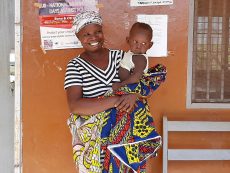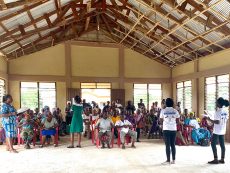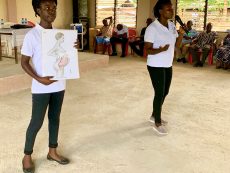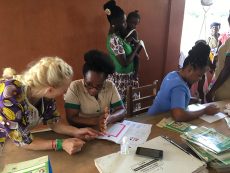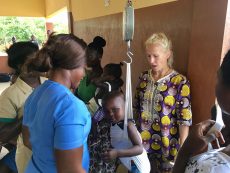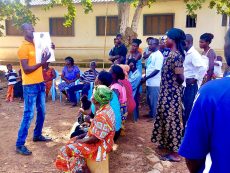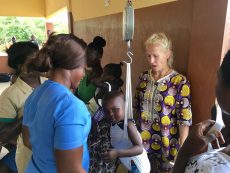
Maternity Program
Medical care for pregnant women and newborns – for healthy mothers and children
The background
Maternal mortality and disease rates among newborns are still high in Ghana. In concrete terms, this means that in 2017 the death rate of mothers of every 100,000 live births was 310. At the same time, the number of women who died from complications from pregnancy rose from 1,020 to 3,100.
This means that pregnant women, mothers and newborns die every day.
Numerous institutions and the government of Ghana are tackling this serious problem. And we as Madamfo Ghana also do our part in the fight against maternal mortality.
It has therefore proven to be urgently necessary to expand our activities in relation to this sad situation on a large scale – and we did that with your support.
Specifically, this means: Since November 2014, we have extended our aid measures from the Ashanti Region to Brong Ahafo-, Central- and Northern Region.
The causes of maternal mortality
We have identified the following factors as the main causes of maternal mortality and increasing morbidity in newborns:
- Lack of health care facilities. The majority of communities do not have health centers. Pregnant women have no access to prenatal care. In view of this, pregnant women are cared for either by traditional healers or by others, especially women who have already given birth. However, these usually do not have the necessary medical knowledge to guide the women safely through pregnancy and delivery.
- Low patronage of antenatal care. There are some communities who have appropriate health centers, but midwives are not consulted, because many pregnant women do not consider this important.
- Inadequately qualified staff. In some areas, health center workers have insufficient knowledge of pregnancy and pregnancy-related complications. Even problems that – with the right medical knowledge can easily be solved – can have negative effects on mother or child during childbirth and can lead to their death.
- Long ways to prenatal care. There is no sufficient coverage of prenatal care and hardly no transportation means to the maternity clinics. For this reason, many pregnant women do not use prenatal care, because the distances are too long for them.
- Financial constraints. Poverty is one of the main causes of maternal mortality and diseases of newborns. Most healthcare facilities do not have essential ultrasound scanners. The pregnant women would therefore have to travel long distances to facilities with ultrasound scanners, but cannot afford them for financial reasons. Family planning, birth preparation or other measures that could help pregnant women are therefore usually not carried out.Also, certain foods that women eat do not contain the nutritional values necessary for pregnant and unborn babies. In addition, most families have no financial reserves to care for pregnant women and newborns.
- Low level of education and little knowledge of pregnancies and related complications. Most people, both men and women, know little about pregnancy and related problems. The lack of knowledge in this area often has negative consequences for pregnant women and newborns.
- Dominant superstition. The beliefs prevailing in communities, which are often based on pure superstition, also contribute to maternal mortality and disease rates among newborns. For example, there is a superstition that pregnant women, for example, are not allowed to eat certain protein foods that would be beneficial to the development of pregnancy and the unborn child. There is also a widespread belief that a woman should not show up during the first third of the pregnancy. In some regions there is also a belief that the firstborn child must die, so that the subsequent siblings have a chance of survival. All of these ideas contribute significantly to the high maternal mortality and disease rate among newborns.It is therefore urgently necessary to specifically inform people about pregnancy and the associated precautions and possible complications. Furthermore, further persuasion must be done, so that more pregnant women take advantage of the prenatal care offers.
The project
In order to effectively remedy the various grievances, the project is structured as follows:
- A team of specialists and trained staff will inform and educate the population in suitable places and in areas, where there are no health centers and health services available.
- There will be held targeted discussions and educational measures on the topics of pregnancy and related complications. These instructions are aimed primarily at pregnant women, who do not use prenatal care.
- On-the-job training for staff, with little knowledge of pregnancies and births or inadequate experience in certain areas of pregnancy care should be created on site. This can be carried out at regular intervals for employees by means of grants and workshops.
- A team of professionals can overcome the problem of long distances and then teach both the male and female population on site in each community.
- The population must be made more aware of the need for financial reserves. This is the only way to ensure that both women before and after childbirth, as well as newborns can be adequately cared for. The poorest women, who cannot save money themselves, need the support of aid and welfare organizations.
- Experts, traditional leaders and opinion leaders must be committed to fighting superstitions. Possible means for this are symposia, discussions and informative videos.
- It must be made clear to people that a woman should consult a midwife or health care professional immediately after the absence of menstruation and take their advice.
Please support our Maternity Outreach Programme
A team of experts and well trained personnel reaches out and educates the population, to raise
awareness in areas without health care centers or health care services.
Status: in realisation since 2014
Costs: 360€ per training for a entire village



